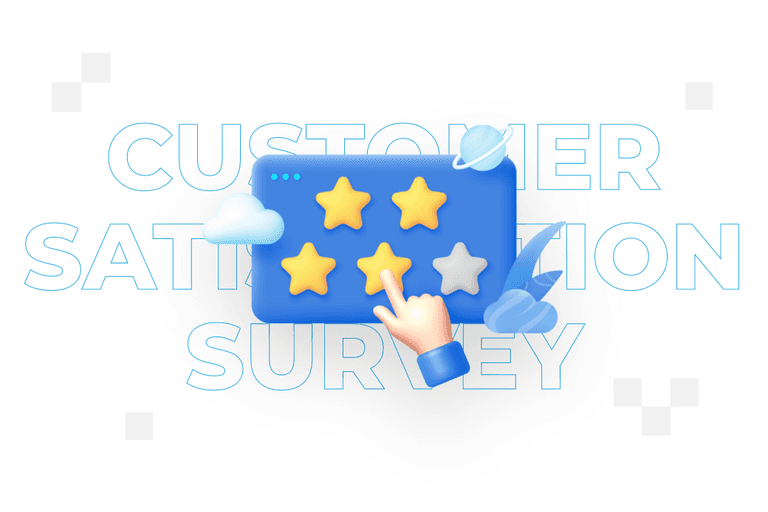
Customer satisfaction survey – what it is and how to conduct it

In the age of the digital revolution, where competition depends on the click of a mouse, customer satisfaction is gaining a new dimension. It is no longer just an indicator of success, but is becoming a factor that determines survival in the market. What, then, is the key strategy to ensure customer satisfaction and, consequently, the success of your business? It is the measurement and analysis of customer satisfaction.
Without it, you are like the captain of a ship who does not know the exact direction of travel. From this article you will learn:
- Why is customer satisfaction research important?
- What are the different methods of customer satisfaction research?
- What are the different qualitative research techniques?
- What is customer interaction analysis?
- What is customer experience?
Customer satisfaction research is the process of gathering information and opinions from customers in order to understand their level of satisfaction with products, services or experiences with a particular company. The purpose of a customer satisfaction survey is to assess whether a company is meeting customers’ needs and expectations to identify areas for improvement.
Customer satisfaction survey – definition
Regular customer satisfaction survey – why is it so important?
Do you want to avoid hitherto loyal customers leaving for the competition? Or perhaps you are keen to attract new customers?Then ongoing monitoring and analysis of customer satisfaction is the answer.
Why is customer satisfaction so important? First and foremost because efforts to acquire potential customers are up to several times more expensive than retaining an existing customer.
As we mentioned earlier, customer loyalty is profitable in every respect, so it is worth measuring customer satisfaction on an ongoing basis and thus appreciating those customers who have bought our product repeatedly and have been with us for a long time.
Importantly, by meeting a customer’s expectations, there is a good chance that they will bring more customers to us. If the level of customer satisfaction is low, just one negative review of the customer, for example on the Google My Company business card, distances us from acquiring new customers and may even deprive us of some of our existing customers.
Customer satisfaction research methods
Customer satisfaction is key to the success of your brand. To keep your customers happy with your services or products, it’s worth trying the following ways to help you win their hearts and loyalty.
Customer satisfaction survey – the most popular method of quantitative data collection.
It can be used to easily measure customer satisfaction. It is one of the most common ways to collect customer feedback. They can be conducted both online and offline and include questions relating to customer satisfaction, product/service quality, customer service, etc. When creating a survey, it is worth spending a little more time on it. It will be important to define its purpose, select and vary the questions, pay particular attention to their order and ensure the respondent’s anonymity.
In this way, we can gain a lot of valuable information and draw the right conclusions from it. It will also be good practice to send out pre-surveys to the customer immediately after they have purchased the goods or services.
We divide these surveys into:
- PAPI survey (Paper & Pen Interview) – this is a traditional survey method in which the respondent is given a printed questionnaire and answers the questions themselves by ticking the appropriate boxes or writing the answers by hand.
- CAPI (Computer – Assisted Personal Interviewing) – is a data collection method that combines traditional survey research with the use of computer technology. In CAPI, the respondent fills in the questionnaire on an electronic device, such as a tablet or laptop, instead of on paper.
- A CAWI ( Computer – Assisted Web Interviewing) survey, which is acomputer-assisted interview via a website. In simple terms, it is a method of collecting data and information in which the respondent completes surveys electronically.
- CATI ( Computer – Assisted Telephone Interviewing)survey – is a technique in which interviewers use computer software and ask survey questions during a telephone conversation.
Additional customer satisfaction survey methods:
- Internet monitoring: checking information about the company on the Internet, through social media mentions, blogs, forums, podcasts, among others, will help us to provide information on customer feelings and opinions about our business. Among the Internet and Social Media monitoring tools we can mention are: Newspoint SentiOne, or NapoleonCat.
- Meetings with customers: direct conversations with customers, such as business meetings, can provide valuable insights into their satisfaction. We thus gain the opportunity to directly ask questions, clarify doubts or discover details about their experience.
Qualitative research
Qualitative research in marketing is a method of gathering information and analysing data to interpret consumer behaviour, preferences and needs. They are based on qualitative data analysis rather than quantitative measurements. A distinction is made among them:
- FGI – a research tool used to gather information from respondents about their opinions, preferences, behaviours or experiences. The term itself is derived from the abbreviation Focus Group Interview and refers to a qualitative research method in which a group of people come together to discuss and debate a specific topic under the guidance of a moderator.
- IDI (In-depth Interview) – a research method, used in the social sciences, marketing and other fields, which involves conducting an in-depth interview with a respondent based on a scenario; it is often a complement or alternative to an FGI study.
- A case study, the main purpose of which is to illustrate a specific case, occurring within the structures of a given company, its goals, activities or objectives. It aims to broaden the knowledge of the audience by presenting the company from a previously unknown point of view. In simple terms, it serves an educational purpose, i.e. learning about the company in every aspect.
- Mystery Shopping is a research technique in which a person, called a MysteryShopper, goes to a place or shop to assess the quality of service, standards of operation, etc. The Mystery Shopper is asked to observe, analyse, and evaluate the business. He or she is asked to observe, analyse and report his or her observations on various aspects of the service, provided by the company.
Customer interaction analysis
Customer interaction analysis is another way of monitoring a customer’s interactions with a company, such as phone calls, emails, live chats, etc. It can provide a wealth of information about the quality of customer service and the level of customer satisfaction. It is divided into, among other things:
Customer satisfaction index
This is a measure that is used to assess the overall satisfaction of customers with an interaction, product or service. CSAT (Customer Satisfaction Score) is often used by companies to monitor the quality of customer service and measure the level of customer satisfaction.
It is measured by a short survey question that customers answer on a rating scale, such as 1 to 5 or 1 to 10. The question may read: How satisfied are you with our service, or On a scale of 1 to 10, how would you rate our product/service? It is calculated based on the proportion of customers who gave a positive answer in relation to the total number of answers given. Its final score is expressed as a percentage and indicates the percentage of satisfied customers.
NPS (Net Promoter Score)
A measure used in business to assess customer satisfaction and loyalty to a brand, company or product. NPS is based on a question that reads: On a scale of 0 to 10, how likely are you to recommend our company/product, service to others?
On the basis of their answers, respondents are divided into 3 categories: promoters, i.e. loyal and satisfied customers, whose score exceeded 9; neutral, i.e. customers who are engaged, but less so than their predecessors, whose score did not exceed 8; detractors, i.e. dissatisfied customers who may negatively influence the image of the company, product or brand in the future – their score on the 10-point scale did not exceed 6. It is this last group that may discourage others from using a given brand’s product or service.
The result of the survey is calculated in a simple way by subtracting the percentage of promoters from the percentage of detractors. The NPS score can equally range from -100 to 100, where higher values indicate greater customer loyalty. Importantly, an increase in the NPS score is also directly related to an increase in the company’s revenue.
CES (Customer Effort Score)
This is a simple, single-interaction focused customer satisfaction survey. It measures the effort a consumer had to put in to achieve an intended goal, including buying a product, making a complaint, etc. The most common question in the Customer Effort Score method will be: How easy was it to resolve a problem with our technical support? This is accompanied by a 5-point scale, where 1 will mean Very Easy and 5 will mean Very Difficult.
Whichever form of satisfaction survey you decide on, make sure it is accessible. Also make sure it is sent at the right time, in the right form, in a graphic template or as a reward for completing the survey, for example in the form of a discount on your products. All of this together significantly increases the chances of a customer participating in the survey.
Customer experience
When writing about customer satisfaction surveys, it is impossible not to mention their impact on customer experience. This term, which is gaining popularity, is nothing more than the sum of all interactions between a customer and an organisation.
Customer experience includes, among other things, customer service, as well as the customer’s emotions and previous experiences with our or a similar brand. Therefore, in order to stand out in the market, it is important to ensure that every interaction with the customer is a great experience that directly exceeds their expectations. The quality of this relationship should be based on pre-defined targets in customer service, which should guide us in taking possible measures to improve customer satisfaction.
In this way, he will be happy to contact us again, or to recommend us further, knowing that his case has been handled simply and effectively, without requiring much commitment from him. As a result, he won’t even think for a second about moving to a competitor. This is why, when running your own business, it is so important that a customer-focused attitude characterises all employees – from the lowest to the highest level.
Keep in mind that when you are running your business, you need to implement both a customer satisfaction survey and a customer experience builder as soon as possible. Make it a kind of ritual in your company’s operations. It is a worthwhile investment that will bring you many benefits, such as building a positive image of your company as a trustworthy brand. Although there are many ways to measure customer satisfaction, we are sure that, through trial and error, you will soon find a solution that perfectly matches your brand profile.
Contact form
Develop your brand
Rate content:
You may be interested in:




